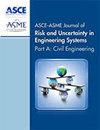Reliability-Based Structural Design of Retaining Walls Supporting Spatially Variable Soils
IF 2.7
3区 工程技术
Q2 ENGINEERING, CIVIL
Asce-Asme Journal of Risk and Uncertainty in Engineering Systems Part A-Civil Engineering
Pub Date : 2022-01-01
DOI:10.1061/ajrua6.0001240
引用次数: 1
Abstract
design of retaining walls is affected by spatial variability in the properties of the retained backfill and the foundation soil. In practice, the conventional approach for designing retaining walls is deterministic in nature and is based on ensuring acceptable design factors of safety for different limit states of wall failure. The only exception is the design method that is available in Eurocode 7, where partial load and resistance factors have been recommended to ensure a target level of safety in the design. Although these codes are considered to include the uncertainties in the design load and capacity, the recommended partial safety factors may not realistically incorporate the impact of spatial variability in the properties of the supported backfill and foundation soil on the design, since the calibration studies that were conducted to determine the safety factors were not based on realistic random field modeling of the soils involved. In addition, existing reliability-based design approaches for retaining walls focus on the failure in the soil and do not include design aspects of the structural behavior of the wall. The main objective of this thesis is to quantify the level of risk associated with the design of a cantilever retaining wall using the conventional deterministic design approaches and approaches that are based on partial factors of safety (ex. Eurocode 7). The objective will be attained by utilizing random fields that represent the variability in the backfill and foundation soils in the finite difference software FLAC 2D ® . The effect of the properties of the random field on the design of the retaining wall will then be investigated to provide recommendations that would aid the design of cantilever walls supporting cohesionless backfill.基于可靠性的空间变土挡土墙结构设计
挡土墙的设计受到填土和地基土的空间变异性的影响。在实践中,传统的挡土墙设计方法本质上是确定性的,并且是基于确保不同墙体破坏极限状态下可接受的设计安全系数。唯一的例外是欧洲规范7中可用的设计方法,其中建议部分负载和阻力因素以确保设计中的目标安全水平。尽管这些规范考虑了设计荷载和能力的不确定性,但推荐的部分安全系数可能无法实际考虑受支撑回填体和基础土特性的空间变异性对设计的影响,因为为确定安全系数而进行的校准研究并非基于所涉及的土壤的现实随机场模型。此外,现有的基于可靠性的挡土墙设计方法侧重于土壤中的破坏,而不包括墙的结构性能的设计方面。本文的主要目标是使用传统的确定性设计方法和基于部分安全因素的方法(例如欧洲规范7)来量化与悬臂挡土墙设计相关的风险水平。该目标将通过利用有限差分软件FLAC 2D®中表示回填土和基础土可变性的随机场来实现。然后将研究随机场特性对挡土墙设计的影响,以提供有助于设计支撑无黏性回填的悬臂墙的建议。
本文章由计算机程序翻译,如有差异,请以英文原文为准。
求助全文
约1分钟内获得全文
求助全文
来源期刊

Asce-Asme Journal of Risk and Uncertainty in Engineering Systems Part A-Civil Engineering
Engineering-Building and Construction
CiteScore
5.30
自引率
8.00%
发文量
86
期刊介绍:
The journal will meet the needs of the researchers and engineers to address risk, disaster and failure-related challenges due to many sources and types of uncertainty in planning, design, analysis, construction, manufacturing, operation, utilization, and life-cycle management of existing and new engineering systems. Challenges abound due to increasing complexity of engineering systems, new materials and concepts, and emerging hazards (both natural and human caused). The journal will serve as a medium for dissemination of research findings, best practices and concerns, and for the discussion and debate on risk and uncertainty related issues. The journal will report on the full range of risk and uncertainty analysis state-of-the-art and state-of-the-practice relating to civil and mechanical engineering including but not limited to:
• Risk quantification based on hazard identification,
• Scenario development and rate quantification,
• Consequence assessment,
• Valuations, perception, and communication,
• Risk-informed decision making,
• Uncertainty analysis and modeling,
• Other related areas.
Part A of the journal, published by the American Society of Civil Engineers, will focus on the civil engineering aspects of these topics. Part B will be published by the American Society of Mechanical Engineers focusing on mechanical engineering.
 求助内容:
求助内容: 应助结果提醒方式:
应助结果提醒方式:


